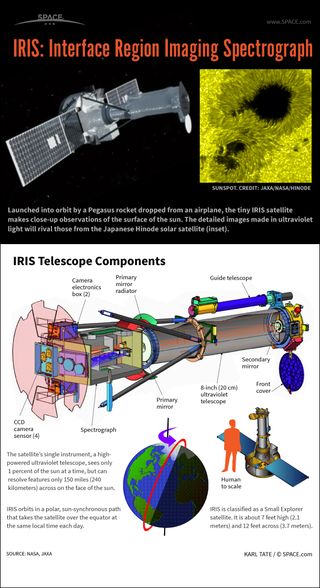NASA Sees Spectacular Sun Eruption Like Never Before (Video)
A tiny NASA space observatory built to snap unprecedented view of the sun has captured its first video of a violent eruption of super-hot solar plasma from the surface of Earth's parent star.
NASA's sun-watching IRIS spacecraft spotted the solar eruption, called a coronal mass ejection (CME), surging off the sun on May 9. Video footage from IRIS shows the amazing explosion with a stream of charged particles and hot plasma spewing from the sun at speeds up to 1.5 million mph (2.4 million km/h).
The IRIS solar observatory (the name is short for Interface Region Imaging Spectrograph) launched into space last year on a mission to study the sun's surface in extreme detail. [Photos: NASA's IRIS Sun Observatory Mission in Space]

CMEs occur when the sun's twisting magnetic field lines become so warped that they snap and break like over-stretched rubber bands, releasing a burst of plasma and solar particles. These explosions occur frequently; in a period of high solar activity, the sun may produce as many as five CMEs in a given day. But IRIS can only peer at 1 percent of the sun at a time, meaning its chances of catching a CME are relatively low.
"We focus in on active regions to try to see a flare or a CME," Bart De Pontieu, the IRIS science lead at Lockheed Martin Solar & Astrophysics Laboratory in Palo Alto, California, said in a statement from NASA. "And then we wait and hope that we'll catch something. This is the first clear CME for IRIS so the team is very excited."
The advantage of IRIS's small field view is that the spacecraft's imaging systems can resolve features as small as 150 miles (240 km) across. IRIS's up-close look at the sun also give scientists an unprecedented view of the chromosphere, the layer of the sun's lower atmosphere just above the surface, which regulates the flow of solar energy and material traveling into space.
On March 29, IRIS — along with three other sun-watching spacecraft and a ground-based observatory — witnessed a powerful X-class solar flare, making it the best-observed flare in history.
Get the Space.com Newsletter
Breaking space news, the latest updates on rocket launches, skywatching events and more!

With its solar panels extended, IRIS measures just 7 by 12 feet (2.1 by 3.7 m) and weighs 400 pounds (181 kilograms). The spacecraft belongs to NASA's Small Explorer program, which puts a budget cap of $120 million on each mission.
Follow Megan Gannon on Twitter and Google+. Follow us @Spacedotcom, Facebook or Google+. Originally published on Space.com.
Join our Space Forums to keep talking space on the latest missions, night sky and more! And if you have a news tip, correction or comment, let us know at: community@space.com.

Megan has been writing for Live Science and Space.com since 2012. Her interests range from archaeology to space exploration, and she has a bachelor's degree in English and art history from New York University. Megan spent two years as a reporter on the national desk at NewsCore. She has watched dinosaur auctions, witnessed rocket launches, licked ancient pottery sherds in Cyprus and flown in zero gravity on a Zero Gravity Corp. to follow students sparking weightless fires for science. Follow her on Twitter for her latest project.
